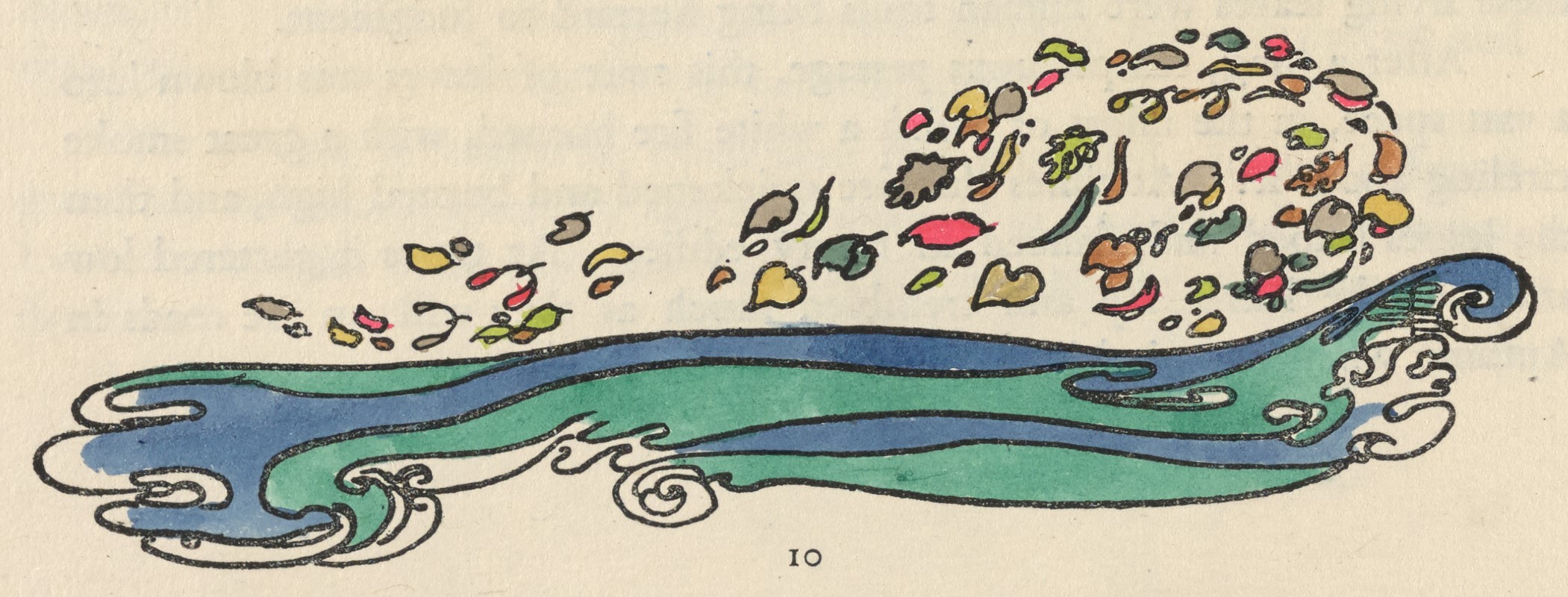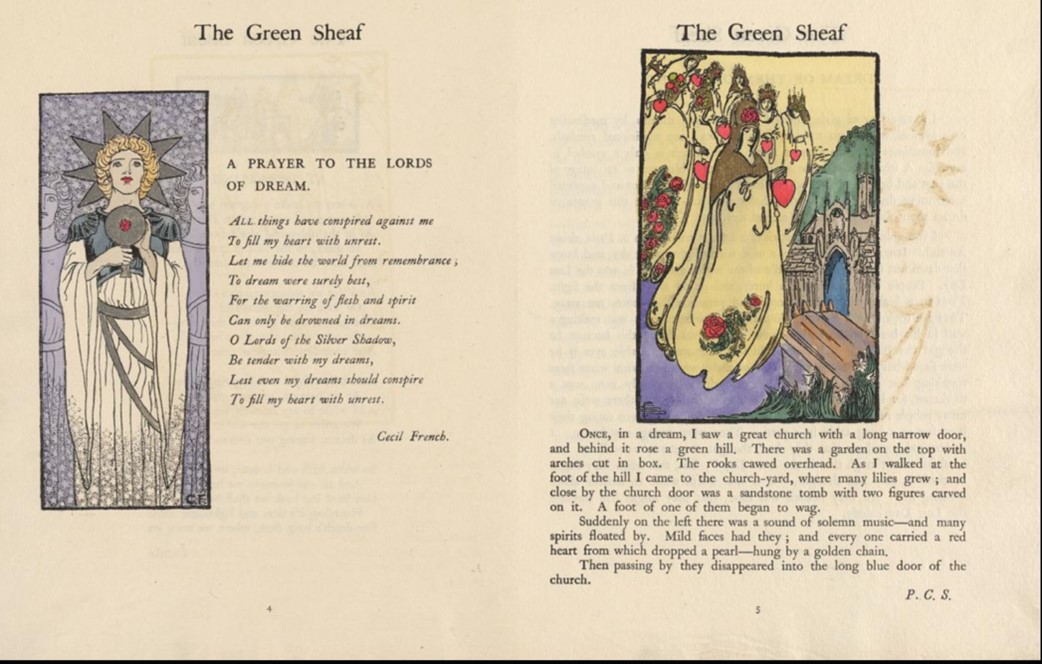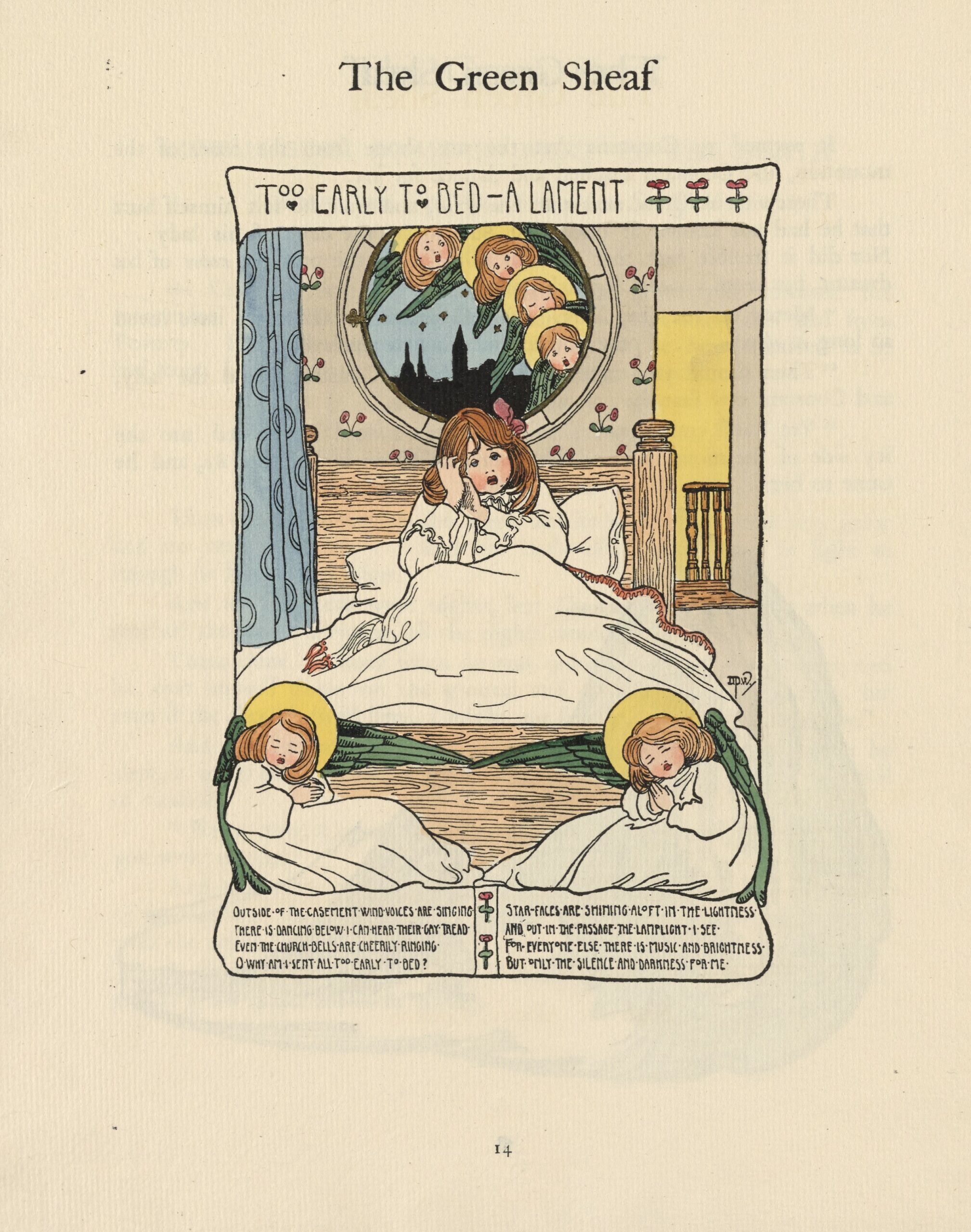Critical Introduction to The Green Sheaf
No. 2, 1903

To set the thematic keynote for an issue dedicated to dreams, visions, and endings that lead into the eternal, Pamela Colman Smith (1878-1951) introduced the second Green Sheaf with an excerpt from her admired predecessor, William Blake (1757-1827). Like Blake, Smith was influenced by the teachings of Emanuel Swedenborg (1668-1772), a philosopher, scientist, and mystic who believed in the correspondence between physical and spiritual worlds (O’Connor 15). In this untitled piece taken from A Vision of the Last Judgment, Blake asserts the correspondence between the “world of the imagination” and “the world of eternity”; it is in the latter that “the eternal realities of everything” exist, rather than in the “finite and temporal” world of generative nature (Untitled, 2). A similar theory of correspondences informed the mystical teachings of the Rosicrucians and the Hermetic Order of the Golden Dawn, with which Smith and some other Green Sheaf contributors were associated. The Green Sheaf’s second number explores material/spiritual correspondence in a series of literary pieces, illustrations, and a supplement devoted to seeing time and space differently. The palette for the issue (fig. 1) draws on the five hues outlined in the colour theory developed by Albert Munsell (1858-1918), which Smith learned from her teacher Arthur Dow (1857-1922) when she studied art at the Pratt Institute in Brooklyn. According to Dow, the principal hues of red, green, violet-blue, yellow, and purple form “the basis of all colour expression in art” (Dow 102). In Smith’s hand-colouring palette, these hues and their various tints correspond to moods and meanings expressed in The Green Sheaf’s second issue.
The monthly number is more expansive than the first in its material format as well as its spiritual vision. Extending to sixteen pages plus a supplement, this issue includes work by nine authors and five artists, each approaching the theme of dreams or visions in their own way. Some of these incorporate end-of-world themes, in keeping with the keynote set by the excerpt from Blake’s Vision of the Last Judgement. Irish artist, agricultural economist, and journalist A.E. (aka George Russell, 1867-1936) provides the illustrative supplement, “A Million Years Hence.” The lurid print shows a surreal apocalyptic landscape with tiny human figures grouped around a massive green skull on a cliff set against a violet-blue and yellow background; in some copies, the violet-blue shades into purple. W. B. Yeats’s “Dream of the World’s End” and John Masefield’s “Jan A Dreams” also relay apocalyptic visions. An Irish revivalist and member of the Golden Dawn, Yeats (1865-1939) records a “grotesque dream about the breaking of eternal day” (6). His friend Masefield (1878-1967) presents a dream in which he joins a flurry of autumn leaves, each one representing a human soul “hurried to Judgment” by a great wind, which bears them up to join the planets and the sea “in the great music of created things” (9, 10). Smith punctuates Masefield’s vision with a hand-coloured illustration showing autumn leaves in red, green, tan, and gold whirling above the cresting waves of a blue and green sea (fig. 2). Smith would later to adapt this image to decorate a lyric by Evelyn Garnaut Smalley (1869-1938) in The Green Sheaf’s final number (see Database of Ornament).

The emerging Irish author and playwright John Millington Synge (1871-1909) published one of his first pieces in The Green Sheaf’s second number. “A Dream on Inishmaan” records a vision he experienced while staying in the Irish-speaking islands on the country’s west coast. As in Masefield’s dream, Synge’s synesthetic experience combines the senses of touch, sight, and sound as he “is swept away in a whirlwind of notes” (8). However, the whirlwind of music and motion moves quickly from joy to agony, and he awakens with the conviction that a “psychic energy” is attached to the place (ibid). Synge was to include this piece in his first book, Aran Islands (1907), a collection of journal entries based on the geography and people he met over the course of his west country travels (Bruns 18).

On the recto of the second page opening, Smith’s self-illustrated, untitled piece describes her dream of a host of spirits entering a church on a green hill, singing and carrying pendant hearts. The action of the dream is initiated when the foot on a recumbent tomb effigy moves, suggesting the apocalyptic beginning of the Last Day and the resurrection of the dead. In the image, the spirits stand on a purple cloud, wearing yellow-washed robes against a yellow sky; in Smith’s symbolic use of colours, these hues tend to be associated with the immaterial world (fig. 3). The scheme corresponds to the colouration of Cecil French’s border illustration on the verso of the double-page spread. The image for “A Prayer to the Lords of Dream” uses a muted purple background to indicate the starry host behind the principal figure, whose rose-emblazoned mirror suggests a Rosicrucian initiation into the correspondence between the physical body and the inner spirit (Rosicrucian 5). Although the metallic paint from French’s image has transferred over to the facing page, letterpress and hand-coloured images harmonize well across the opening, associating both works with a desire for rest beyond the fret of mortal life. This desire is also captured in “La Tranquillita,” a full-page pen-and-ink drawing by W. T. Horton (1864-1919) who was, like Smith and Yeats, at one time a member of the Order of the Golden Dawn. Through a dense frame of pomegranate trees and flowering vines, Horton depicts a quiet harbour and a medieval keep. Pastoral and pre-industrial tropes are regular features of The Green Sheaf’s imaginary. Horton’s illustration recalls one of Smith’s earlier images in the issue, depicting a pilgrim with staff and scrip looking toward a turreted castle. This headpiece image accompanies the poem “At Departing,” by the pseudonymous Lucilla (3).
“Lucilla” was the pen name used by Grace E. Tollemache (1869-1934), an author, activist, and suffragist with connections to members of The Green Sheaf circle. As his advertisement at the back of the number indicates, Elkin Mathews (1851-1921), the magazine’s distributor, had published Songs of Lucilla in 1901 (Advertisements 15). Mathews’ list also advertises work by other Green Sheaf contributors, including W.B. Yeats’s Wind Among the Reeds (4th ed.); two of Pamela Colman Smith’s hand-coloured ballads, The Golden Vanity and the Green Bed and Widdicombe Fair (first published by Doubleday and McClure in 1899); and back issues of A Broad Sheet from 1902, which Smith had co-edited and hand-coloured with Jack Yeats (1871-1957).
Notably, the advertising page also announces the Dun Emer Press publication of W.B. Yeats’s In the Seven Woods: Poems Chiefly of the Irish Heroic Age, hand-printed and rubricated by his sister Elizabeth (1868-1940). As always, Smith’s Green Sheaf advertisements make visible her networks of association in the arts communities of Ireland and England. Smith had contributed to Dun Emer—a women-operated arts-and-crafts establishment founded in 1902 by Evelyn Gleeson (1855-1944) and Elizabeth and Lily Yeats (1866-1949)—from its inception, giving advice about the hand press and providing designs for book plates and textiles (Bowe and Cummings 123-125). Smith’s support of women entrepreneurs in The Green Sheaf’s back pages is also evident in the advertisements for Edith Craig’s costume-hiring shop and for Rosa Baillie’s services as a professional lace-maker (Smith, Illustrated Advertisement 16). Baillie advertises “Point-Lace made to order and Lessons on request,” with designs made by Pamela Colman Smith. Rosa Baillie (dates unknown) worked out of the home she shared with her brother John (1866-1926) at 1 Prince’s Terrace, Bayswater, where the Baillie Gallery was located. The New Zealand artist opened his dealer gallery in London in 1901; despite the non-central location, Baillie quickly gained a reputation for artistic taste and a willingness to exhibit marginalized artists, including colonials, gays, and women (Mackle 65). A number of Green Sheaf artists, including Cecil French, Elinor Monsell (1871-1954), and Pamela Colman Smith, exhibited their work at the Baillie Gallery. In time for the Christmas season of 1903/4, John Baillie ventured into publishing with The Venture, a short-lived annual co-edited by Laurence Housman (1865-1959) and Somerset Maugham (1874-1965). More complement than rival to Smith’s monthly magazine, The Venture featured a number of Green Sheaf contributors. Its second volume in 1905 included a hand-coloured print by Smith and an advertisement for her recently opened shop in Knightsbridge (Smith, “Autumn Leaves” and “The Green Sheaf”). In 1908, Smith gave one of her performances of West Indian folk tales in the character of Gelukiezanger at Baillie’s Gallery (“Miss Colman-Smith’s Story-Telling”). In numerous ways, as Marion Grant suggests, Smith and Baillie, both ex-patriot artists and entrepreneurs, promoted each other’s goods and services as well as those of women and other marginalized individuals (Grant, par. 11).

Smith chose to end The Green Sheaf’s second number with the end of the day rather than the end of the world. “Too Early to Bed—A Lament,” by Dorothy P. Ward (1879-1969) captures the distress of a little girl whose inconvenient bedtime prevents her from joining the evening’s activities (fig. 4). The illuminated poem’s contrast with the preceding item by Christopher St. John (aka Christabel Marshall, 1871-1960) is startling. Continued from the first number, the concluding installment of St. John’s “How Master Constans Went to the North” is tinged with an erotic charge. The story ends with Constans piercing the crystal mountain to reach his beloved Princess of the North: his “faith like flame melted the ice, and he came to her” (13). In a number opening with Blake’s statement about the imagination, the penultimate item resonates with the words of another romantic poet. Just as John Keats maintained that “The Imagination may be compared to Adam’s dream—he awoke and found it truth,” so too the quester’s dream becomes embodied beauty and truth when Constans unites with his soul-mate in St. John’s imaginative retelling of Celtic legend (Keats 1274). As the issue’s final piece, Ward’s illuminated poem embodies this notion of sleeping and waking differently. Integrating the physical world of Dublin, whose skyline rises behind the sleepless girl, with the spiritual world of seraphim, the iconography of “Too Early to Bed” makes a fitting end to an issue devoted to vision and correspondence.
©2022 Lorraine Janzen Kooistra, FRSC, Emerita Professor of English and Senior Research Fellow, Centre for Digital Humanities, Toronto Metropolitan University
Works Cited
- Advertisements. The Green Sheaf, No. 2, 1903, pp. 15-16. Green Sheaf Digital Edition, edited by Lorraine Janzen Kooistra, Yellow Nineties 2.0, Toronto Metropolitan University Centre for Digital Humanities, 2022, https://1890s.ca/GSV2-ads/.
- A.E. [George Russell]. “A Million Years Hence.” Illustrative Supplement to The Green Sheaf, No. 2, 1903, n.p. Green Sheaf Digital Edition, edited by Lorraine Janzen Kooistra, Yellow Nineties 2.0, Toronto Metropolitan University Centre for Digital Humanities, 2022, https://1890s.ca/GSV2-supplement/.
- Blake, William. A Vision of the Last Judgment. Complete Poetry and Prose of William Blake, edited by David V. Erdman, revised edition, Doubleday, 1982, p. 69. The William Blake Archive, http://erdman.blakearchive.org/
- —. Untitled. [“The World of Imagination”], illustrated by W. T. Horton. The Green Sheaf, No. 2, 1903, p. 2. Green Sheaf Digital Edition, edited by Lorraine Janzen Kooistra, Yellow Nineties 2.0, Toronto Metropolitan University Centre for Digital Humanities, 2022. https://1890s.ca/GSV2-blake-vision/.
- Bowe, Nicola Gordon and Elizabeth Cumming. The Arts and Crafts Movements in Dublin and Edinburgh 1885-1925. Irish Academic Press, 1998.
- Bruns, Guilia. J.M. Synge and Travel Writing of the Irish Revival. Syracuse University Press, 2017.
- Dow, Arthur Wesley. Composition: A Series of Exercises in Art Structure for the Use of Students and Teachers. Doubleday, 1913.
- French, Cecil. “A Prayer to the Lords of Dream,” illustrated by Cecil French. The Green Sheaf, No. 2, 1903, p. 4. Green Sheaf Digital Edition, edited by Lorraine Janzen Kooistra, Yellow Nineties 2.0, Toronto Metropolitan University Centre for Digital Humanities, 2022, https://1890s.ca/GSV2-french-prayer/.
- Grant, Marion. “Advertising Women’s Entrepreneurship in The Green Sheaf: Pamela Colman Smith and the Fin-de-Siècle Marketplace.” Nineteenth-Century Gender Studies, Special Issue on “Women and Other ‘Undesirables’: Female Creative and Technical Labor in Nineteenth-Century Print Culture,” edited by Jocelyn Hargrave and Megan Peiser, vol. 18, no. 2, Summer 2022, 22 pp. http://ncgsjournal.com/issue182/index.html/.
- Horton, W. T. “La Tranquillita.” The Green Sheaf, No. 2, 1903, p. 11. Green Sheaf Digital Edition, edited by Lorraine Janzen Kooistra, Yellow Nineties 2.0, Toronto Metropolitan University Centre for Digital Humanities, 2022, https://1890s.ca/GSV2-horton-tranquillita/.
- —. Illustration for Untitled [“The World of Imagination”], by William Blake. The Green Sheaf, No. 2, 1903, p. 2. Green Sheaf Digital Edition, edited by Lorraine Janzen Kooistra, Yellow Nineties 2.0, Toronto Metropolitan University Centre for Digital Humanities, 2022, https://1890s.ca/GSV2-horton-blake.
- Keats, John. Letter to Benjamin Bailey, November 22, 1817. English Romantic Writers, 2d edition, edited by David Perkins, Harcourt Brace, 1995, pp. 1174-75.
- Lucilla. “At Departing,” illustrated by Pamela Colman Smith. The Green Sheaf, No. 2, 1903, p. 3. Green Sheaf Digital Edition, edited by Lorraine Janzen Kooistra, Yellow Nineties 2.0, Toronto Metropolitan University Centre for Digital Humanities, 2022, https://1890s.ca/GSV2-lucilla-departing/.
- Mackle, Tony. “The Enterprising John Baillie, Artist, Art Dealer and Entrepreneur.” Tuhinga, vol. 28, 2017, pp. 62-79.
- Masefield, John. “Jan A Dreams,” illustrated by Pamela Colman Smith. The Green Sheaf, No. 2, 1903, pp. 9-10. Green Sheaf Digital Edition, edited by Lorraine Janzen Kooistra, Yellow Nineties 2.0, Toronto Metropolitan University Centre for Digital Humanities, 2022, https://1890s.ca/GSV2-masefield-jan/.
- “Miss Colman-Smith’s Story-Telling.” Reprinted from The Times (London), February 4, 1908. Pamela Colman Smith: The Untold Story, by Stuart Kaplan with Mary K. Foley O’Connor and Melinda Boyd Parsons, U.S. Games Systems, 2018, p. 284.
- O’Connor, Elizabeth Foley. “Pamela’s Life.” Pamela Colman Smith: The Untold Story, by Stuart R. Kaplan, with Mary K. Greer, Elizabeth Foley O’Connor, and Melinda Boyd Parsons. U.S. Games Systems, 2018, pp. 11-99.
- Rosicrucian Initiation. Neophyte Section. AMORC, Grand Lodge of the English Language Jurisdiction of the Ancient & Mystical Order Rose Crucis, 2007. http://findyourtemple.weebly.com/uploads/4/3/9/3/43932849/rosicrucian-atrium1-initiation.pdf
- St John, Christopher. “How Master Constans Went to the North” [2nd installment], illustrated by Pamela Colman Smith. The Green Sheaf, No. 2, 1903, pp. 12-13. Green Sheaf Digital Edition, edited by Lorraine Janzen Kooistra, Yellow Nineties 2.0, Toronto Metropolitan University Centre for Digital Humanities, 2022, https://1890s.ca/GSV2-st-john-constans/.
- Smalley, Evelyn Garnaut. “The Wind,” decorated by Pamela Colman Smith. The Green Sheaf, No. 13, 1904, p. 7. Green Sheaf Digital Edition, edited by Lorraine Janzen Kooistra, Yellow Nineties 2.0, Toronto Metropolitan University Centre for Digital Humanities, 2022, https://1890s.ca/GSV13-smalley-wind/.
- Smith, Pamela Colman. “Autumn Leaves.” The Venture, vol. 2, 1905, p. 28. Venture Digital Edition, edited by Lorraine Janzen Kooistra, Yellow Nineties 2.0, Toronto Metropolitan University Centre for Digital Humanities, 2022, https://1890s.ca/ventureV2-smith-leaves/.
- —. Advertisement for The Green Sheaf, Knightsbridge. The Venture, vol. 2, 1905, p. 193. Venture Digital Edition, edited by Lorraine Janzen Kooistra, Yellow Nineties 2.0, Toronto Metropolitan University Centre for Digital Humanities, 2022. https://1890s.ca/venturev2-ads/.
- —. Illustrated Advertisement for Edith Craig & Co. The Green Sheaf, No. 2, p. 16. Green Sheaf Digital Edition, edited by Lorraine Janzen Kooistra, Yellow Nineties 2.0, Toronto Metropolitan University Centre for Digital Humanities, 2022. https://1890s.ca/gsv2-craig-ad/.
- —. Illustration for “Jan A Dreams,” by John Masefield. The Green Sheaf, No. 2, 1903, p. 10. Green Sheaf Digital Edition, edited by Lorraine Janzen Kooistra, Yellow Nineties 2.0, Toronto Metropolitan University Centre for Digital Humanities, 2022. https://1890s.ca/GSV2-smith-jan-illustration/.
- —. Untitled. [“A Dream”], illustrated by Pamela Colman Smith. The Green Sheaf, No. 2, 1903, p. 5. Green Sheaf Digital Edition, edited by Lorraine Janzen Kooistra, Yellow Nineties 2.0, Toronto Metropolitan University Centre for Digital Humanities, 2022, https://1890s,ca/GSV2-smith-dream/.
- Synge, J. M. “A Dream on Inishmaan.” The Green Sheaf, No. 2, 1903, pp. 8-9. Green Sheaf Digital Edition, edited by Lorraine Janzen Kooistra, Yellow Nineties 2.0, Toronto Metropolitan University Centre for Digital Humanities, 2022, https://1890s.ca/GSV2-synge-inishmaan/.
- Ward, Dorothy. “Too Early to Bed: A Lament.” The Green Sheaf, No. 2, 1903, p. 14. Green Sheaf Digital Edition, edited by Lorraine Janzen Kooistra, Yellow Nineties 2.0, Toronto Metropolitan University Centre for Digital Humanities, 2022, https://1890s.ca/GSV2-ward-lament/.
- Yeats. W. B. “Dream of the World’s End.” The Green Sheaf, No. 2, 1903, pp. 6-7. Green Sheaf Digital Edition, edited by Lorraine Janzen Kooistra, Yellow Nineties 2.0, Toronto Metropolitan University Centre for Digital Humanities, 2022, https://1890s.ca/GSV2-yeats-worlds-end/.
MLA citation: Kooistra, Lorraine Janzen. “Critical Introduction to The Green Sheaf No. 2, 1903.” Green Sheaf Digital Edition, Yellow Nineties 2.0, edited by
Lorraine Janzen Kooistra, Toronto Metropolitan University Centre for Digital Humanities,
2023. https://1890s.ca/gsv2_introduction/.